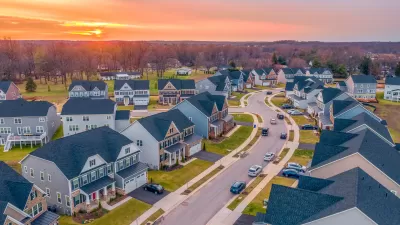When it came out in 2004, "The End of Suburbia" was required viewing for anti-sprawl activists. Now, four years later, the film is both quaint and frighteningly prophetic, writes Dorothy Woodend.
"As a film, The End of Suburbia is a blunt instrument. It hits you over the head with talking heads and huge amounts of info. But what it lacks in style, The End of Suburbia makes up in prescience.
The film was released in 2004, when oil was still a mere $38 per barrel. With the price currently hovering around $110, the film seems almost quaint in light of the recent market meltdowns, credit crises and other alliterative issues. But many of the ideas that the documentaries initially broached have only become increasingly pressing in recent years. The grim reality of the situation has resulted in oil executives stating openly that there is indeed a problem.
Mr. Kunstler's ideas comprise a good portion of the The End of Suburbia, and he's a very convincing speaker, quick with a quip to sum up the current state of what he calls Clusterfuck Nation...He blows his wheels off occasionally, but usually in an entertaining fashion. To his credit, Kunstler admits that his own job might not be very useful in the future. No more book tours, no more mass paperbacks. He predicts he might eventually start a local newspaper. His most recent book, World Made by Hand, posits a more hopeful version of scaled down future. Thinking how much might possibly change, it's very easy to fall into fantasy land, either idyllic or not.
After I watched the film, I walked to Safeway to get stuff for breakfast, and found myself standing transfixed in the cereal aisle, staring at a box of Special K that cost almost nine dollars. A box of cereal reaching perilously close to double digits in price? 'When did this happen?' I wanted to ask somebody. The distant rumblings of food riots in faraway places, and the doubling of the price of rice reported this week by the New York Times, all came flooding in.
Maybe this was it, the actual first damp touch of the tidal wave."
FULL STORY: 'The End of Suburbia'

Alabama: Trump Terminates Settlements for Black Communities Harmed By Raw Sewage
Trump deemed the landmark civil rights agreement “illegal DEI and environmental justice policy.”

Planetizen Federal Action Tracker
A weekly monitor of how Trump’s orders and actions are impacting planners and planning in America.

The 120 Year Old Tiny Home Villages That Sheltered San Francisco’s Earthquake Refugees
More than a century ago, San Francisco mobilized to house thousands of residents displaced by the 1906 earthquake. Could their strategy offer a model for the present?

Indy Neighborhood Group Builds Temporary Multi-Use Path
Community members, aided in part by funding from the city, repurposed a vehicle lane to create a protected bike and pedestrian path for the summer season.

Congestion Pricing Drops Holland Tunnel Delays by 65 Percent
New York City’s contentious tolling program has yielded improved traffic and roughly $100 million in revenue for the MTA.

In Both Crashes and Crime, Public Transportation is Far Safer than Driving
Contrary to popular assumptions, public transportation has far lower crash and crime rates than automobile travel. For safer communities, improve and encourage transit travel.
Urban Design for Planners 1: Software Tools
This six-course series explores essential urban design concepts using open source software and equips planners with the tools they need to participate fully in the urban design process.
Planning for Universal Design
Learn the tools for implementing Universal Design in planning regulations.
Clanton & Associates, Inc.
Jessamine County Fiscal Court
Institute for Housing and Urban Development Studies (IHS)
City of Grandview
Harvard GSD Executive Education
Toledo-Lucas County Plan Commissions
Salt Lake City
NYU Wagner Graduate School of Public Service





























